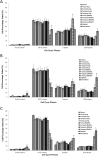Inhibition of Raf-MEK-ERK and hypoxia pathways by Phyllanthus prevents metastasis in human lung (A549) cancer cell line
- PMID: 24138815
- PMCID: PMC4015811
- DOI: 10.1186/1472-6882-13-271
Inhibition of Raf-MEK-ERK and hypoxia pathways by Phyllanthus prevents metastasis in human lung (A549) cancer cell line
Abstract
Background: Lung cancer constitutes one of the malignancies with the greatest incidence and mortality rates with 1.6 million new cases and 1.4 million deaths each year. Prognosis remains poor due to deleterious development of multidrug resistance resulting in less than 15% lung cancer patients reaching five years survival. We have previously shown that Phyllanthus induced apoptosis in conjunction with its antimetastastic action. In the current study, we aimed to determine the signaling pathways utilized by Phyllanthus to exert its antimetastatic activities.
Methods: Cancer 10-pathway reporter array was performed to screen the pathways affected by Phyllanthus in lung carcinoma cell line (A549) to exert its antimetastatic effects. Results from this array were then confirmed with western blotting, cell cycle analysis, zymography technique, and cell based ELISA assay for human total iNOS. Two-dimensional gel electrophoresis was subsequently carried out to study the differential protein expressions in A549 after treatment with Phyllanthus.
Results: Phyllanthus was observed to cause antimetastatic activities by inhibiting ERK1/2 pathway via suppression of Raf protein. Inhibition of this pathway resulted in the suppression of MMP2, MMP7, and MMP9 expression to stop A549 metastasis. Phyllanthus also inhibits hypoxia pathway via inhibition of HIF-1α that led to reduced VEGF and iNOS expressions. Proteomic analysis revealed a number of proteins downregulated by Phyllanthus that were involved in metastatic processes, including invasion and mobility proteins (cytoskeletal proteins), transcriptional proteins (proliferating cell nuclear antigen; zinc finger protein), antiapoptotic protein (Bcl2) and various glycolytic enzymes. Among the four Phyllanthus species tested, P. urinaria showed the greatest antimetastatic activity.
Conclusions: Phyllanthus inhibits A549 metastasis by suppressing ERK1/2 and hypoxia pathways that led to suppression of various critical proteins for A549 invasion and migration.
Figures







References
-
- Ye MX, Zhao YL, Li Y, Miao Q, Li ZK, Ren XL, Song LQ, Yin H, Zhang J. Curcumin reverses cis-platin resistance and promotes human lung adenocarcinoma A549/DDP cell apoptosis through HIF-1alpha and caspase-3 mechanisms. Phytomedicine. 2012;13(8–9):779–787. - PubMed
-
- Yao H, Zhang Z, Xiao Z, Chen Y, Li C, Zhang P, Li M, Liu Y, Guan Y, Yu Y. et al.Identification of metastasis associated proteins in human lung squamous carcinoma using two-dimensional difference gel electrophoresis and laser capture microdissection. Lung Cancer. 2009;13(1):41–48. doi: 10.1016/j.lungcan.2008.10.024. - DOI - PubMed
Publication types
MeSH terms
Substances
LinkOut - more resources
Full Text Sources
Other Literature Sources
Medical
Miscellaneous

